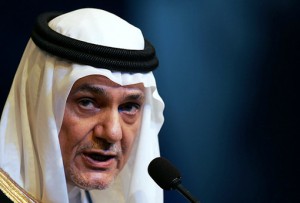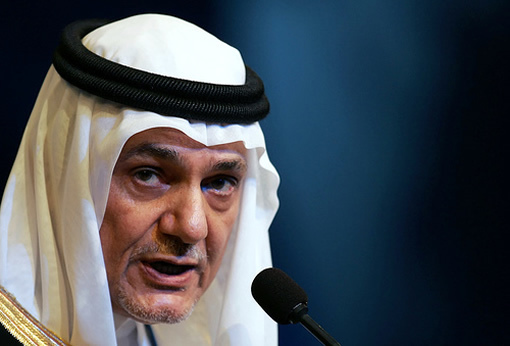
This is the final installment in a three-part series that examines the historical foundations, current dynamics, and future prospects of the relationship between Iran and Saudi Arabia. Parts I and II provided historical and contemporary accounts of the two countries’ often turbulent relationship since 632 and 1979, respectively; part III is an analysis of the parallels between the Iran-Saudi conflict and the U.S.-Soviet Union Cold War.
During a speech to the South Carolina House of Representatives in April 1947, U.S. presidential advisor and financier Bernard Baruch told his fellow countrymen that, “We are today in the midst of a cold war.” This utterance was the first of its kind directly referring to the often strained and potentially calamitous ideological, military and economic confrontation between the United States and the Soviet Union during the latter half of the twentieth century. Although many refrain from using the phrase when describing contemporary international relations, the bilateral relationship between Iran and Saudi Arabia is impossible to ignore as a clear example of modern-day cold warfare.
Since the birth of the modern Islamic Republic of Iran in 1979, the rivalry between Iran and Saudi Arabia has yielded many of the same symptoms which came to define the Cold-War between the U.S. and U.S.S.R. Similarities include: nuclear proliferation, proxy wars, blocs and alliances, a noticeable détente period, propaganda, espionage, and the influence of non-state actors. By considering this volatile situation and all its disastrous potential, policy makers can take preemptive action through diplomacy to minimize the possibility of ‘hot’ warfare occurring between the two countries. In assessing how Iran and Saudi Arabia have and continue to display symptoms of cold warfare, it is helpful to study the background and rationale behind the conflict and also the characteristics that have come to define it.
The initial fissure in the Iran-Saudi Arabia relationship occurred centuries ago when a dispute ensued between two groups – later Sunni and Sh’ia Muslims – over the rightful successor to the Prophet Mohammed. Saudi Arabia became the de-facto leader of the Sunni Muslim world, while Iran, just across the Gulf, embraced the Sh’ia cause. This ideological battle closely resembles the backbone and heart of the original Cold War in which U.S. capitalism and democracy faced off with Soviet socialism.
Over the past thirty years, both Iran and Saudi Arabia have attempting to spread their conflicting ideologies and advance their own similar, but divergent foreign policy goals; mainly, regional control through gradual accumulation of support. While neither Iran nor Saudi Arabia is prepared for full-scale military intervention to advance those ends (as the U.S. was in Vietnam or the USSR was in Afghanistan) they instead see religion, arms and money as their most powerful assets in their quest for regional domination.
As a result, rather than engaging in hot warfare, both sides have instead come to rely on third party proxy wars to attack and weaken their enemy and their allies. The indirect waging of war by heavily supporting those fighting ones opponent does not formally crush relations, as would direct war, but strains them heavily. Though such tactics have a long history dating back to colonial America, proxy wars as we know them today were originally perfected by the U.S. and the Soviet Union over the course of the original Cold War. Both sides took to funding and arming their ideological partners so as to weaken the opposing side. Notable examples include of U.S.-Soviet proxy wars include: the Vietnam War (1957-1965), the Korean War (1950-1953), the Soviet War in Afghanistan (1979-1989), and the Cuban Revolution (1953-1959).
Such behavior has been mirrored in the ongoing Iran-Saudi Arabia Cold War. A war fought between Iran and Iraq during the 1980’s offers a case in point of this dynamic in play. Over the course of the war the Saudi government heavily funded Saddam Hussein’s Iraqi Army as they fought the Iranian Revolutionary Guards. The ten-year war caused massive destruction on both the Iranian and Iraqi sides and ended with almost one million people dead. The Lebanese Civil War is another example of a proxy war in which Iranian backed Hezbollah fought Saudi backed Sunni militias during the 1980s and 1990s.
Since that time, both sides have remained on the offensive and have built up their respective alliance blocs, in effect mirroring the containment strategy first developed by the U.S. during the Cold War. Iran has provided arms and financial support to Hezbollah in Lebanon, Hamas in the Palestinian territories and militias in Yemen.[i] During the War in Iraq, Tehran provided both weapons and logistical support to the country’s Sh’ia, some of whom were part of the deadly 2006 insurgency, and have continued to do so since. Syria has historically been one of Iran’s most consistent allies and has provided the Islamic Republic with diplomatic support and a literal gateway through which to expand into the Middle East for decades. This alliance is vital for an increasingly isolated Iran, however, the longevity and viability of this relationship has been put in doubt by the year-old uprising against Syrian President Basher al-Assad.
While examples of Saudi proxy wars are lesser in number than those of Iran, the Gulf Kingdom has instead relied most heavily on diplomacy and religion to advance its foreign policy objectives. The Saudis have for years been building up their alliance blocs which include other Sunni controlled states like Morocco, Egypt, and Turkey and the other Gulf oil monarchies. The conservative Saudi kingdom has supported only one uprising since the Arab Spring began last winter; Syria’s. It has done so in a bid to eliminate a powerful foe, weaken its main ally, Iran, and thus strengthen its own hand. In addition to funding and arming like-minded bodies, they also have funded non-state actors like the Taliban network in Afghanistan and Pakistan.
A vital commonality between both the American-Soviet Cold War and the new Iranian-Saudi Arabian one is the involvement of nuclear weapon development or at least the threat of their use against one another.
During the original Cold War, mutual fears between the U.S. and the U.S.S.R. in regard to nuclear weapons resulted in a terrifying arms race with each superpower developing and deploying enormous stockpiles of nuclear weapons. Although both sides had about 25,000 warheads in the late 1970s, the Soviets arsenal continued to grow up to 40,000 warheads in the mid 1980s while the U.S. continued a gradual decline.[ii]
The “opaque nuclear program” of Iran has worried the world as it is not completely transparent and many believe that it is aimed at developing a nuclear weapon. While Iran claims the program is peaceful, skepticism remains, especially for states in close proximity to Iran, like Israel and Saudi Arabia.[iii] Despite frequent rejections by energy officials in Tehran that nuclear weaponry is being produced, many find it difficult to imagine the radical republic is solely using its technology for civilian projects.
Skeptics fear that the development of an Iranian nuclear weapon could result in an arms race reminiscent of the original Cold War. Prince Turki Al-Faisal of Saudi Arabia has demanded his conservative Islamic kingdom ”look into all options we are given, including obtaining [nuclear] weapons ourselves” if Iran successfully completes its intentions to do so.[iv]
The relationship between Saudi Arabia and Iran has certainly shown signs of cold warfare, many of which are strikingly similar to those that occurred during the U.S.-Soviet Cold War for a large part of the twentieth century. Without the attention of the globe upon them every day, both countries act as “behind-the-scenes people” as they execute decisions with potential to change the international climate in an instant. As a conflict that is “generally relegated to rhetoric and diplomatic gestures, not concrete action”, the relationship between the two countries may pass under the radar for a considerable amount of time before it erupts.[v]
[i] Apps, Peter. “Analysis: “Cold War” with Iran heats up across Mideast.” Reuters, Last modified December 5, 2011. http://www.reuters.com/article/2011/12/05/us-iran-coldwar-idUSTRE7B41GC20111205.
[ii] “Figure of US and USSR/Russian Nuclear Stockpile, 1945-2002.” Natural Resources Defense Council, Last modified November 25, 2002. Accessed March 16, 2012. http://www.nrdc.org/nuclear/nudb/dafig11.asp.
[iii] Joshi, Shashank. “Hostility between Iran and Saudi Arabia is going to get worse.” The Telegraph, Last modified October 12, 2011. http://www.telegraph.co.uk/news/worldnews/northamerica/usa/8822785/Hostility-between-Iran-and-Saudi-Arabia-is-going-to-get-worse.html.
[iv] Daily Mail Reporter. “Saudi Arabia may need nuclear weapons to fend off threat from Iran and Israel, says former intelligence chief.” Daily Mail, Last modified December 6, 2011. Accessed February 26, 2012. http://www.dailymail.co.uk/news/article-2070704/Saudi-Arabia-need-nuclear-weapons-fend-threat-Iran-Israel-says-prince.html.
[v] Leigh, Karen. “The Saudi-Iran Cold War: Will the Assassination Plot Heat It Up?.” Time, Last modified October 13, 2011. http://http://www.time.com/time/world/article/0,8599,2096764,00.html.



